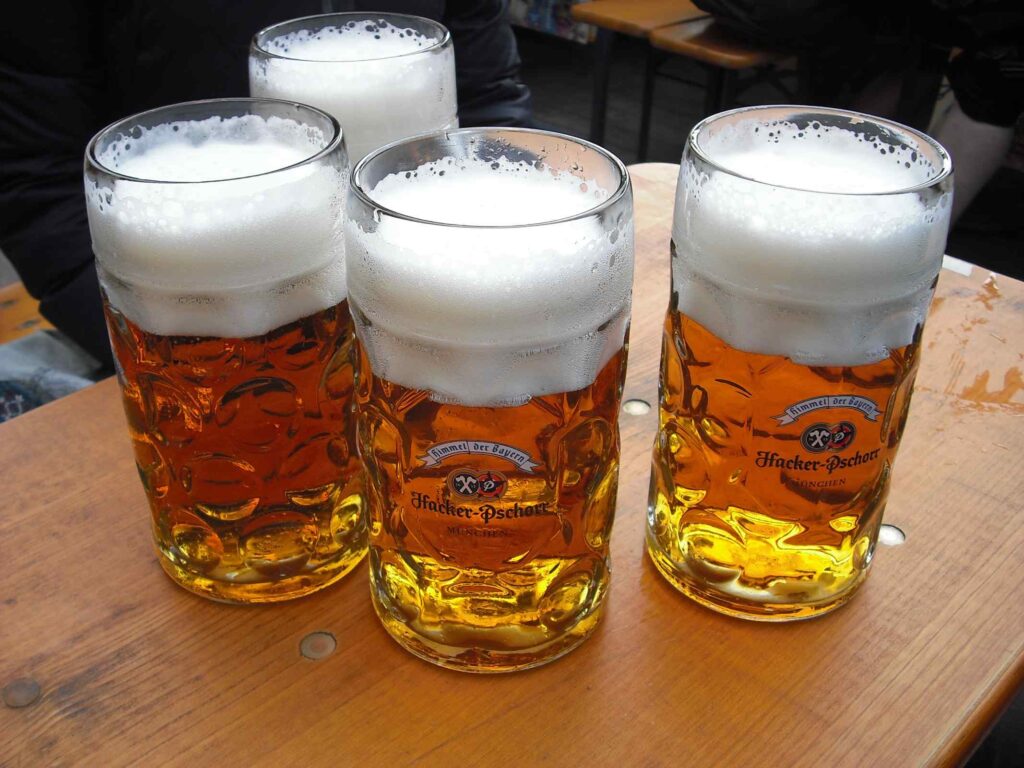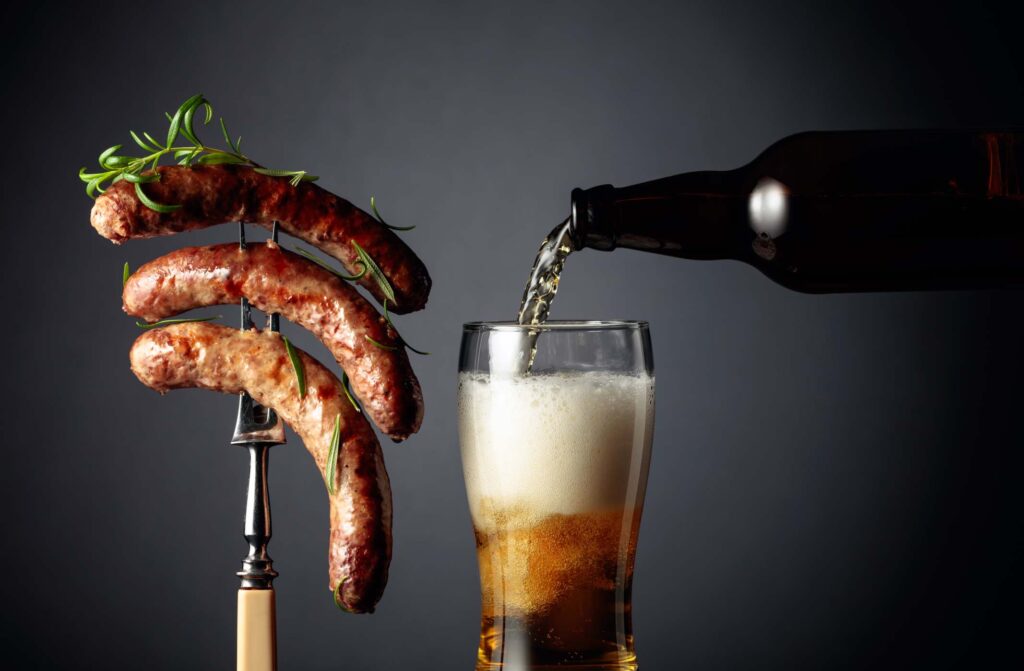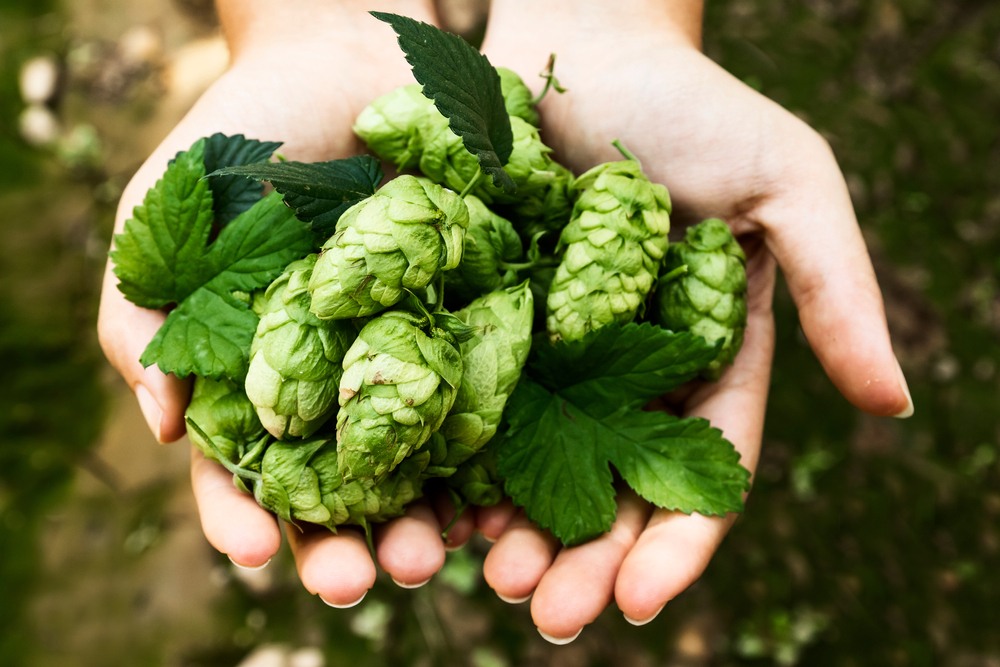What is Marzen? In this article, you will learn interesting facts about Marzen.
Märzen, a traditional German beer style, has an intriguing history, origin, and taste profile that has captured the attention of beer enthusiasts around the world. This unique lager was historically brewed during the month of March, giving it its name, and was typically stored in caves to be enjoyed throughout the summer months.
The original Märzen was dark, strong, and full-bodied, crafted using roasted Vienna and caramelized Munich malt, which allowed the beer to maintain its flavors despite inevitable changes that occurred during summertime storage.
Austrian Märzenbiers, on the other hand, often use caramel malts that impart a sweeter flavor than their German counterparts, with some even overlapping stylistically with Munich-style Helles. As Märzen has evolved over time, it has become increasingly associated with Oktoberfest celebrations. In fact, a stronger version of the beer was traditionally served at these early gatherings, giving rise to the popular Oktoberfest style.
Today, Märzen-style beers are appreciated for their toasted bread or biscuit-like malt aroma and flavor. With a rich yet approachable taste, this distinctive beer style continues to excite and satisfy the diverse palates of beer drinkers across the globe.
Table of Contents
History of Märzen
Origins in Bavaria
Märzen, also known as Märzenbier, is a lager that originated in Bavaria. Its roots date back to 16th-century Germany, when Bavarian brewers began experimenting with different malts and hops to craft distinct beer styles. The medium to full-bodied lager comes in various colors, ranging from pale to amber and dark brown. Although traditionally served at Munich’s Oktoberfest, the geographical indication “Oktoberfestbier” is only used for Märzens brewed in Munich and is protected under EU law.
March Beer
The name “Märzen” translates to “March Beer” in German, as it was traditionally brewed in March. Since beer brewing was prohibited in Germany from April to September due to concerns about its quality and safety during the warmer months, Bavarian brewers needed to create a beer with higher alcohol by volume (ABV) and abundant hop content to maintain freshness throughout the summer. As Märzen was crafted to achieve this goal, it became a staple during the fall season, particularly at Oktoberfest celebrations.
Winter Brewing
To keep the Märzens fresh for months, the beer was stored in caves to maintain a cool temperature. The combination of increased hops and higher ABV in this beer style prolonged its shelf life, allowing it to last from March until the fall season. Over time, Märzen became closely associated with the autumn months and Oktoberfest.
Märzen is characterized by its medium body, malty flavor, and approachable taste. It is crafted using Munich malts, which offer a bready, biscuit-like flavor with hints of caramel. This lager-style beer also has a light hop flavor that is balanced by the sweetness of the malts, making it easy to drink with medium carbonation.
Märzen vs. Festbier
Traditional Varieties

Märzen, also known as Märzenbier, is a traditional German beer style that was historically brewed in March (März in German) and stored until September or October, just in time for Oktoberfest celebrations. This amber lager is characterized by its elegant, malty flavor with rich, toasty, and bready malt notes, and a restrained bitterness that finishes dry, encouraging another sip.
On the other hand, Festbier is a more modern German lager style that emerged in the late twentieth century as a replacement for Märzen during Oktoberfest festivities. This golden beer is lighter in color and body, making it highly drinkable without compromising on flavor. Initially developed and pioneered by the Paulaner brewery in the early 1970s, Festbier quickly gained popularity for its lower alcohol content and malt sweetness.
Modern Varieties
Märzen has evolved over the years, with Austrian Märzen beers incorporating caramel malts for a sweeter taste and sometimes overlapping stylistically with Munich-style Helles. Meanwhile, Festbier has become the official beer style of Munich’s Oktoberfest, boasting a delicate balance for long binge-drinking sessions by the liter.
In conclusion, while Märzen traditionally marked the end of the brewing season and the beginning of Oktoberfest, modern beer styles have adapted to cater to contemporary tastes. Today, Märzenbier and Festbier each have their distinct qualities, but both continue to be cherished components of Oktoberfest celebrations and beyond.
Märzen Characteristics
Appearance
Märzen, a traditional German beer style, often presents a deep gold-copper hue with brilliant clarity. The color can range from pale to amber and even dark brown, depending on the specific brewing methods and ingredients used. A Märzen’s appearance is further characterized by a persistent and frothy head, making it visually appealing to beer enthusiasts.
Aroma
The aroma of a Märzen beer is predominantly characterized by the presence of caramel and toasted malt, typically derived from Munich or Vienna malt varieties. Alongside these scents, you may also detect a subtle hint of hops, which contributes to the beer’s overall complexity and enticing aroma.
Flavor
When it comes to flavor, Märzen is known for its rich, toasty, and bready malt profile, resulting from the careful combination of ingredients such as Munich malt, Pilsner malt, and often a touch of biscuit or caramel malt. The beer boasts a medium to full body, providing a smooth and satisfying mouthfeel. The fermentation process using specific lager yeast strains imparts a clean and balanced character to the beer, with restrained bitterness and a dry finish that encourages another sip.
Somewhere between ales and the lighter lagers, Märzen showcases a welcoming rich and malty flavor, making it an ideal companion for autumn festivities. The typical ABV for Märzen beers falls between 5% and 6%, striking a balance between potency and drinkability. Carbonation levels in Märzen tend to be moderate, further enhancing the beer’s overall drinkability and refreshment factor.
Brewing Process
The Märzen style beer boasts a rich flavor profile with a unique brewing process that distinguishes it from other lagers. The brewing process consists of the careful selection of malts, hops, and yeast, followed by fermentation to create this traditional Bavarian beer.
Malts
Märzen derives its signature amber color and malty sweetness from the use of Munich and Vienna malts. These specialty malts contribute a depth of flavor and rich, toasted notes. Munich malt is known to provide a sweet, caramel-like character, while Vienna malt contributes a more subtle, bready flavor. A small portion of other malts, like Pilsner or pale lagers, may be added to balance the overall flavor profile.
Hops
When it comes to hops, Märzen typically relies on traditional European varieties to create a balanced bitterness that complements the rich maltiness of the beer. German Noble hops, such as Hallertau and Tettnanger, are commonly used due to their distinct floral and herbal attributes. These hop varieties are also renowned for their low alpha acid content, which imparts a mild bitterness that accentuates the beer’s malty backbone.
Yeast
The yeast selection for Märzen is crucial, as this beer is brewed as a lager. Lager yeasts are specifically designed to ferment at colder temperatures, which results in a cleaner, crisper, and smoother taste profile. These yeasts are originated from the Czech Republic or Northern Europe and have been adopted by American craft brewers to create authentic Märzenbier brews. The lager yeast is instrumental in enhancing the beer’s malt character and promoting a clean, refreshing finish.
Fermentation
Fermentation is a key aspect of the Märzen brewing process due to its unique history. Traditionally, Märzen was brewed in the spring, typically in March, to capitalize on cooler temperatures that minimized the risk of spoilage. The beer would then be stored in caves where it aged over the summer before being served at Oktoberfest celebrations in the fall. During this extended fermentation period, the beer would develop its distinctive flavor, with a medium to full body that would range in color from pale through amber to dark brown.
In summary, the production of Märzen involves the careful selection of malts, hops, and yeast, all contributing to its unique flavor. The fermentation stage plays a vital role in further enhancing this specialty beer, which remains a beloved style in Europe and beyond.
Popular Märzen Beers

American Craft Beers
Several American craft brewers have taken inspiration from the traditional German Märzen style, creating their own unique spins on the beer. Some notable examples include:
- Flying Dog Dogtoberfest: A rich and malty Oktoberfest beer with Munich malts that provide a smooth flavor profile.
- Brooklyn Oktoberfest: A classic take on the Märzen style, it features Vienna lagers and a blend of American and Bavarian hops.
- Left Hand Oktoberfest: A well-balanced Märzen with a toasted malt character and a clean, crisp finish.
- Great Lakes Oktoberfest: A popular choice hailing from Pennsylvania, it is known for its rich, malty sweetness.
- Avery The Kaiser: An imperial take on the Märzen style, with a bold, assertive flavor that stands out from the crowd.
Strictly adhering to traditional brewing practices is not always a priority for American craft brewers, leading to a variety of interpretations such as saison and Vienna lager influences.
German Beers
Germany has a longstanding history with Märzen beers, especially since the first Oktoberfest in Munich. The originators of the style, many breweries in Germany continue to produce some of the best Märzens available:
- Paulaner Oktoberfest Märzen: Paulaner’s Märzen is one of the most popular Oktoberfest beers, known for its robust flavor and amber color.
- Hofbräu Oktoberfestbier: A lighter-bodied Märzen, this beer is crisp and refreshing with a golden hue.
- Spaten Oktoberfest: This classic Märzen boasts a rich, toasty malt character balanced by a subtle hop presence.
Oktoberfest celebrations often include the iconic stein, filled to the brim with these delicious Märzen brews. For beer enthusiasts, attending the event in Munich and enjoying authentic German Märzens is a must. However, the rise of American craft beer has made trying regional interpretations and variations easier than ever, giving beer lovers around the world the opportunity to sample diverse Märzen styles.
Märzen Pairings
Foods

For a delightful culinary experience, pairing a Märzen with appropriate foods is essential. Märzen lagers, with their medium to full body and varying colors from pale to dark brown, have a wide range of flavors to complement different dishes. Their origins in Bavaria and strong associations with Oktoberfest make them a popular choice for fall and seasonal celebrations.
Märzens beautifully pair with a variety of dishes that bring forth the caramel malts, toasted bread, and herbal notes present in the beer. The beer’s mouthfeel enhances both sweet and savory dishes, making it extremely versatile.
For a summer menu, consider pairing a Märzen with grilled or barbecued meats, like sausages and chicken. The caramel malt flavors and herbal notes in the Märzen pair nicely with smoky, charred flavors from the grill.
Adding a side of veggies can elevate your Märzen pairing. Grilled or roasted vegetables topped with a touch of herbs or spices make a fitting companion for the beer’s unique blend of flavors. The Märzen’s herbal notes and mouthfeel balance out the spicy, smoky flavors of the vegetables.
For more adventurous pairings, try combining Märzens with dishes that are simultaneously sweet and savory, such as a Liege-style waffle topped with maple syrup and shaved aged Gouda. The sweetness of the waffle complements the moderate bitterness of the Märzen, while the Gouda adds a fulfilling umami component.
Milder Märzens, like the Wiener Märzen, might work well with lighter fare, such as salads and seafood dishes. The beer’s floral notes and subtle caramel flavors can enhance the taste experience of these meals.
Different Märzen Styles
Helles Märzen
Helles Märzen is a lighter-colored and milder version of the traditional Märzen beer. With a golden hue and a slightly lower ABV, this style offers a more delicate flavor profile compared to other Märzen varieties. Helles Märzen often showcases a balance between malt and hops, with moderate bitterness and a clean, crisp lager character. Its drinkability makes it a popular choice for enjoying during the Oktoberfest season.
Dunkles Märzen
Dunkles Märzen, also known as dark Märzen, features a richer and more robust malt profile. Its deep amber to brown color results from the use of darker malts, offering a toasted and sometimes caramel-like flavor. Despite this, Dunkles Märzen remains balanced with a subtle hop bitterness that prevents it from being too sweet. The lager qualities of this style provide a smooth, clean finish that complements its bolder malt character.
Vienna Lager
Vienna Lager is a style closely related to Märzen but has its own distinct characteristics. Originating in Austria, Vienna Lager features an amber color and a malt-forward profile with a touch of toasted bread and subtle caramel notes. This beer has a slightly higher hop presence than traditional Märzen, resulting in a well-balanced and crisp finish. While not an official Oktoberfest beer, Vienna Lager shares a similar history and brewing process, making it a worthy companion to the Märzen family of beers.



